The Nobel laureates were the first to show this effect for systems containing billions of Cooper pairs. 'Macroscopic' objects described by a collective wavefucntion. Their work laid the foundations for superconducting qubits
They also showed other properties like energy quantisation
7/7
08.10.2025 20:16 — 👍 10 🔁 0 💬 0 📌 0

In superconductors you can build have states where many, many Cooper pairs (pairs of electrons) are described by the same wavefunction, which allows them collectively to tunnel through thin insulator barriers called Josephson junctions
6/7
08.10.2025 20:16 — 👍 7 🔁 1 💬 1 📌 0
But in quantum mechanics one wavefunction doesn't mean one particle. Many particles can be described by the same wavefunction. Entanglement is an example in which multiple particles are described by one wavefunction
5/7
08.10.2025 20:16 — 👍 7 🔁 0 💬 1 📌 0

It is also responsible for field electron emission, used in electron microscopes and tunnel diodes, nuclear fusion in stars, etc
4/7
08.10.2025 20:16 — 👍 8 🔁 0 💬 1 📌 0

This effect isn't uncommon in nature
It explains radioactive alpha-decay where a whole Helium nucleus is emitted from a heavy decaying element even if the binding forces wouldn't allow this process classically
3/7
08.10.2025 20:16 — 👍 8 🔁 0 💬 1 📌 0

..is on the other side of the barrier (unless its an infinitely strong force field)
If you measure the position of the particle there is a finite probability it's outside the trap even if it never had enough kinetic energy to overcome the barrier. It 'tunnels' through the barrier
2/7
08.10.2025 20:16 — 👍 6 🔁 0 💬 1 📌 0

Short explanation of the physics Nobel Prize 2025
In classical mechanics you can know where a particle is and its momentum at the same time. In Quantum mechanics you can't. All information is in the wavefunction. Even if a particle is trapped, part of the wavefunction..
🧵1/7
08.10.2025 20:16 — 👍 42 🔁 10 💬 1 📌 2

This night 102 years ago, Hubble discovered that there're stars outside our galaxy by observing a Cepheid variable star 1 million light years away
Until barely a century ago, no human ever knew whether there was more than one galaxy in the Universe. Think about that!
05.10.2025 19:44 — 👍 67 🔁 14 💬 5 📌 0

These results use Run 2 data. By the end of Run 4, the much larger dataset would push the significance beyond discovery thresholds, if the central value holds
In the plot below we were at the blue, we are now at the red and could be as sensitive as the green markers
6/6
09.09.2025 18:48 — 👍 10 🔁 0 💬 1 📌 0
This type of new physics would have the properties of a new vector boson (like the Z boson) or a leptoquark, a completely new state that connects color-charged quarks with color-neutral muons
5/6
09.09.2025 18:48 — 👍 8 🔁 0 💬 1 📌 0

If it is indeed physics beyond the standard model, the data points toward the same types of interactions that have already been shown to consistently explain several other anomalies in B-meson decays
4/6
09.09.2025 18:48 — 👍 8 🔁 1 💬 1 📌 0
It's an open question whether there is a systematic effect here that shows up in both experiments in the same way, or a theoretical uncertainty that has been underestimated or whether this is a genuine signal that the Standard Model cannot account for
3/6
09.09.2025 18:48 — 👍 9 🔁 1 💬 2 📌 0

The statistical significance is 4.1 standard deviations.
Intriguingly, CMS, another experiment at the Large Hadron Collider, has also measured this process and sees the same anomaly, too
2/6
09.09.2025 18:48 — 👍 9 🔁 0 💬 1 📌 0

Today LHCb presented a new measurement of the decay of a B meson into a K* and a μ+ μ- pair
Previous results disagreed with the Standard Model prediction for the branching fraction and angular distribution
The new measurement has almost twice as much data and still disagrees!
🧵1/6
09.09.2025 18:48 — 👍 48 🔁 14 💬 2 📌 0

And if you consider the limit of x_1 -> x_2 you can see how the Pauli principle follows for fermions
14/14
01.08.2025 21:31 — 👍 7 🔁 0 💬 0 📌 0
The number of different ways to exchange particles and ending up in exactly the same configuration corresponds to different ways a WF transforms under particle exchange. There are only two classes in 3D, so only fermions and bosons. In 2D instead there're anyons (that can have any phase)
13/
01.08.2025 21:31 — 👍 6 🔁 1 💬 1 📌 0

In 2D this can be any complex number with a different phase factor for each winding number. In 3D+ it can be only +1 or -1
12/
01.08.2025 21:31 — 👍 2 🔁 0 💬 1 📌 0

In Quantum mechanics the question is how does the wavefunction describing two identical particles transform under this exchange. This corresponds to an operator O(\lambda) with is a 1-dimensional unitary representation of the fundamental group acting on the WF
11/
01.08.2025 21:31 — 👍 4 🔁 0 💬 1 📌 0
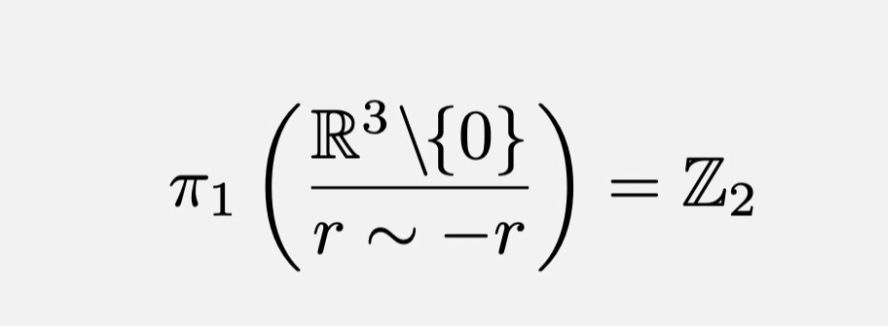
So the fundamental group of the configuration space in 3D+ is the group with exactly 2 elements
10/
01.08.2025 21:31 — 👍 3 🔁 0 💬 1 📌 0
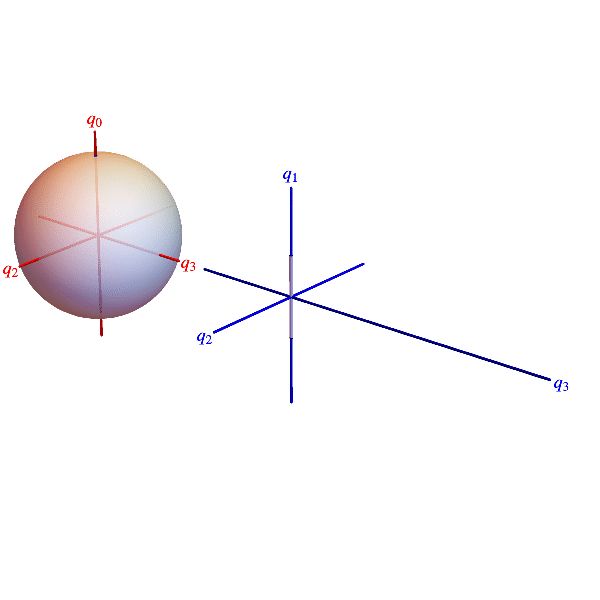
Here is a representation of a non-contractible loop that can't be continuously transformed into a point
9/
01.08.2025 21:31 — 👍 2 🔁 0 💬 2 📌 0

Here is a representation of how the contractible loop can be continuously transformed into a point (=no exchange of the two particles)
Again, the bar on the right part is the line connecting the two particles
8/14
01.08.2025 21:31 — 👍 2 🔁 0 💬 1 📌 0

And closing the q2 loop twice is equivalent to a contractible loop
7/14
01.08.2025 21:31 — 👍 3 🔁 0 💬 1 📌 0
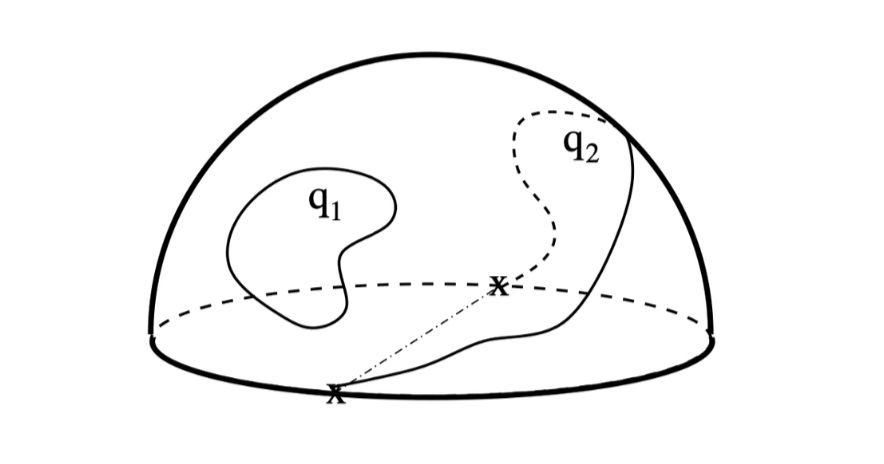
Here, there're only 2 different classes of loops that can't be transformed into each other. Contractible loops (q1) and non-contractible loops (q2)
6/14
01.08.2025 21:31 — 👍 3 🔁 0 💬 1 📌 0
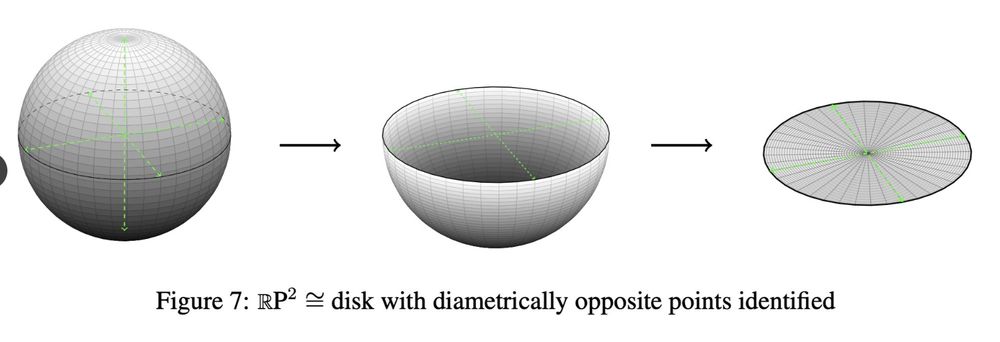
Now in 3D (or higher) the situation is different. Here, the configuration space is a half sphere, or a disk with opposite points identified
5/14
01.08.2025 21:31 — 👍 3 🔁 1 💬 1 📌 0

The different classes of such loops that can't be transformed into each other by stretching and moving them around the cone (w/o a tip) form the first fundamental group of the configuration space
While R^2 is simply connected (every loop can be contracted to a dot), this space is not
4/14
01.08.2025 21:31 — 👍 4 🔁 0 💬 1 📌 0

Any exchange of these two particles corresponds to a loop on this cone
Two loops that can be continually transformed into each other are equivalent. But because the tip of the cone is missing, any number of rotations around the cone can't be transformed into one with fewer or more windings
3/14
01.08.2025 21:31 — 👍 5 🔁 0 💬 1 📌 0

For 2 indistinguishable particles, the configuration in which particle 1 is at r and particle 2 is at -r is equivalent to the configuration where they swap positions
So in 2D, the configuration space is R^2 with opposite points identified (excluding the origin)
This space is a cone w/o a tip
2/14
01.08.2025 21:31 — 👍 5 🔁 0 💬 1 📌 0

In 3 (or more) dimensions, all fundamental particles are either fermions and bosons. But why?
This is a direct consequence of the properties of the configuration space for identical particles
🧵 1/14
01.08.2025 21:31 — 👍 46 🔁 5 💬 4 📌 1
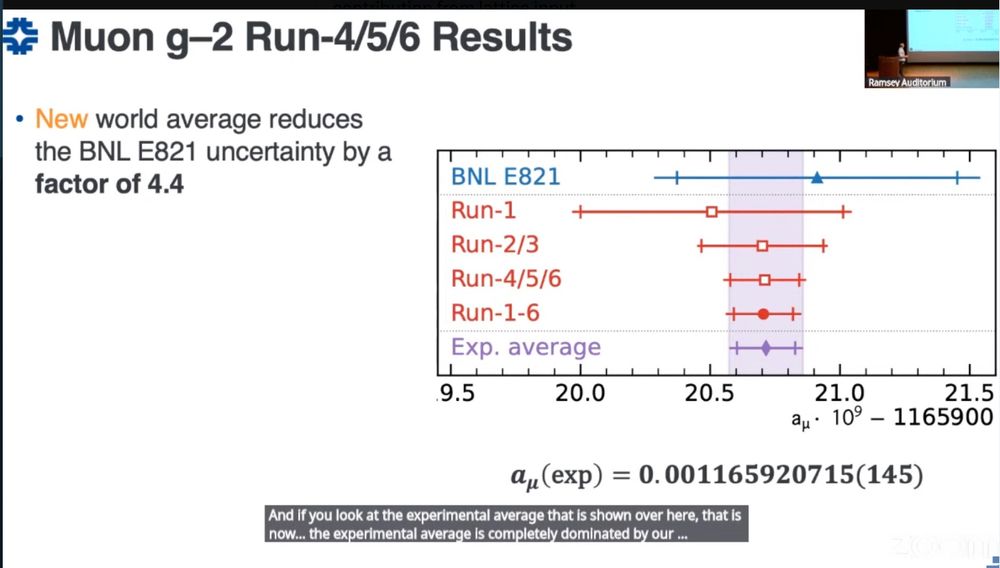
Here is it: The worlds best measurement of the anomalous magnetic moment of the muon
In great agreement with previous experimental results and in agreement with the Standard Model prediction using the LO HVP contribution from lattice input
03.06.2025 16:51 — 👍 30 🔁 2 💬 2 📌 0
America’s Finest News Source. A @globaltetrahedron.bsky.social subsidiary.
Get the paper delivered to your door: membership.theonion.com
Mobilizing the fight for science and democracy, because Science is for everyone 🧪🌎
The hub for science activism!
Learn more ⬇️
http://linktr.ee/standupforscience
Professor of Comparative Democratic Institutions, Nuffield & University of Oxford, FBA. http://benansell.substack.com. BBC Reith Lecturer 2023. Host BBC Radio 4 Rethink. Columnist for Prospect. Director, Centre for Advanced Social Science Methods (CASSM).
PhD student working on machine learning for high energy physics. Interested in equivariant architectures and generative modelling.
Author, essayist, public speaker. Co-founder and co-host of the Stadio football podcast.
Quantum Bullshit Detector.
Tag for a reading.
Uni of Cambridge and LHC physicist (Graduated)
Science communicator and YouTuber
The Bad Boy of Science
Linktree: https://linktr.ee/badboyofscience
Vice-president of the World Liberty Congress. Founder & Chair of the Renew Democracy Initiative. Board of the Human Rights Foundation. Father, activist, author, speaker, 13th World Chess Champion.
Theoretical particle physicist, university professor, nature enthusiast, Wiccan HPS (dual Lexi/Gard), autistic person. She/her.
https://people.physics.carleton.ca/~logan/
I do cosmology and astroparticle theory. I pick apart the Universe to figure out how it works. Science Advisor. Dark Matter hunter.
🇵🇱✡️🇪🇬☪️
Theoretical physicist. Full professor in Rio de Janeiro 🇧🇷. Amateur classical guitarist.
Theoretical and computational biophysicist at Carnegie Mellon University. Loves lipid membranes, music, and art. (he/him) 🇩🇪🇺🇸
Particle physicist at University of Bonn, working on the ATLAS experiment at CERN. https://orcid.org/0000-0001-7050-5301
Dad and occasional particle theory professor
The Future Circular Collider study explores the feasibility of higher performance circular particle colliders that could inaugurate the post-LHC era at CERN 💫
Director Data Science Institute @UWMadison, Professor of Physics,
EiC @MLSTjournal. Physics, stats/ML/AI, open science.
Astrofísico
Santiago - Chile
Bluesky for the blog 4gravitons.com






















